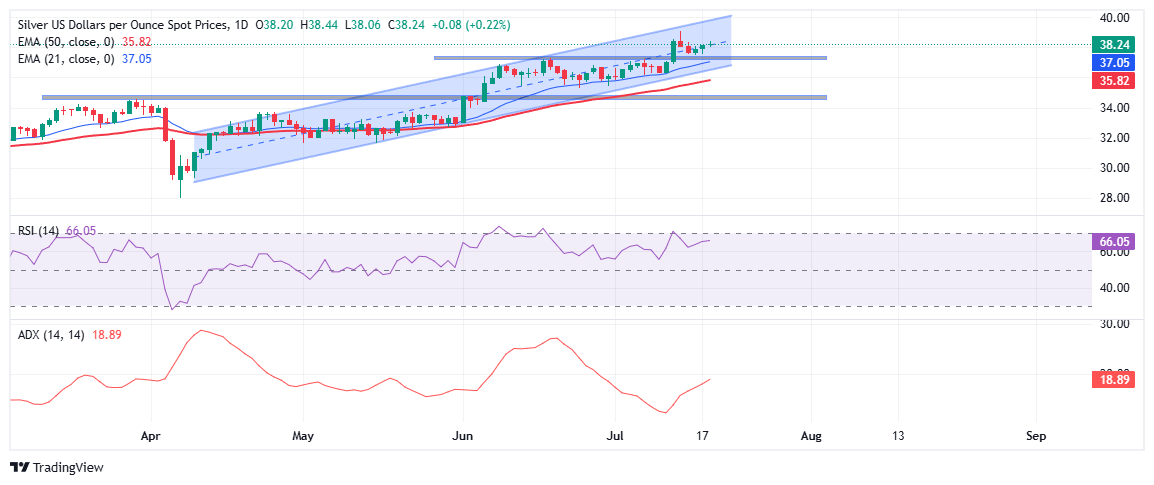Silver Price Forecast: XAG/USD consolidates below multi-year highs
- Silver (XAG/USD) is holding firm near $38.00 after hitting a 14-year high earlier this week.
- The metal remains supported by an ascending channel on daily and weekly charts.
- RSI and ADX on the daily chart are turning higher, signaling a possible return in bullish momentum.

Silver (XAG/USD) is treading water on Friday, with spot prices hovering near $38.25 after marking a fresh 14-year high of $39.13 earlier this week. The metal continues to draw support from a firmly bullish structure, trading within a well-defined ascending channel on both the daily and weekly charts. While momentum has cooled slightly near multi-year highs, the broader technical outlook remains positive, with prices still comfortably positioned above key short-term moving averages.
The 21-day EMA at $37.05 continues to provide dynamic support, while the 50-day EMA near $35.82 offers a solid cushion for any deeper pullbacks.
Although price is consolidating just below the $38.50-$39.00 resistance zone, momentum indicators are beginning to turn higher again. The Relative Strength Index (RSI) eased slightly after nearing overbought territory earlier in the week when Silver hit its 14-year high. However, it has started to slope upward again, currently hovering around 66, pointing to a potential revival in buying interest.
The Average Directional Index (ADX) on the daily chart is also beginning to pick up, suggesting that trend strength may be strengthening after a brief slowdown. These developments indicate that the recent consolidation may be a healthy pause within the broader uptrend, rather than a signal of exhaustion.
Immediate support is seen around $37.00 round number, aligning with the 21-day EMA and marking a key line in the sand for bulls. A break below this level could trigger a deeper pullback, exposing the next support at $35.50, followed by a stronger demand zone near $34.50. On the upside, a sustained move above $39.13 would likely attract fresh buying interest, opening the door for a push toward the psychological $40.00 level and potentially higher.
Silver FAQs
Silver is a precious metal highly traded among investors. It has been historically used as a store of value and a medium of exchange. Although less popular than Gold, traders may turn to Silver to diversify their investment portfolio, for its intrinsic value or as a potential hedge during high-inflation periods. Investors can buy physical Silver, in coins or in bars, or trade it through vehicles such as Exchange Traded Funds, which track its price on international markets.
Silver prices can move due to a wide range of factors. Geopolitical instability or fears of a deep recession can make Silver price escalate due to its safe-haven status, although to a lesser extent than Gold's. As a yieldless asset, Silver tends to rise with lower interest rates. Its moves also depend on how the US Dollar (USD) behaves as the asset is priced in dollars (XAG/USD). A strong Dollar tends to keep the price of Silver at bay, whereas a weaker Dollar is likely to propel prices up. Other factors such as investment demand, mining supply – Silver is much more abundant than Gold – and recycling rates can also affect prices.
Silver is widely used in industry, particularly in sectors such as electronics or solar energy, as it has one of the highest electric conductivity of all metals – more than Copper and Gold. A surge in demand can increase prices, while a decline tends to lower them. Dynamics in the US, Chinese and Indian economies can also contribute to price swings: for the US and particularly China, their big industrial sectors use Silver in various processes; in India, consumers’ demand for the precious metal for jewellery also plays a key role in setting prices.
Silver prices tend to follow Gold's moves. When Gold prices rise, Silver typically follows suit, as their status as safe-haven assets is similar. The Gold/Silver ratio, which shows the number of ounces of Silver needed to equal the value of one ounce of Gold, may help to determine the relative valuation between both metals. Some investors may consider a high ratio as an indicator that Silver is undervalued, or Gold is overvalued. On the contrary, a low ratio might suggest that Gold is undervalued relative to Silver.

